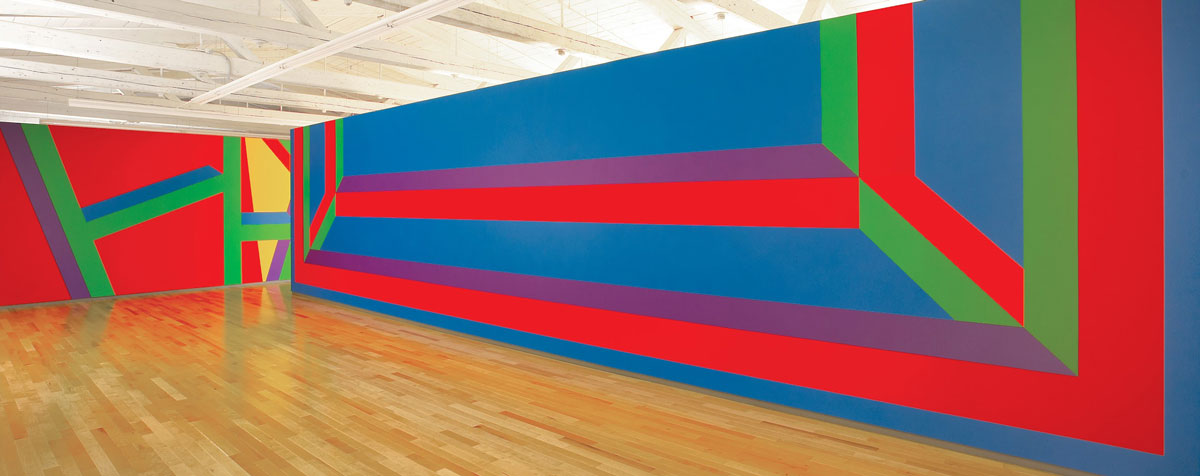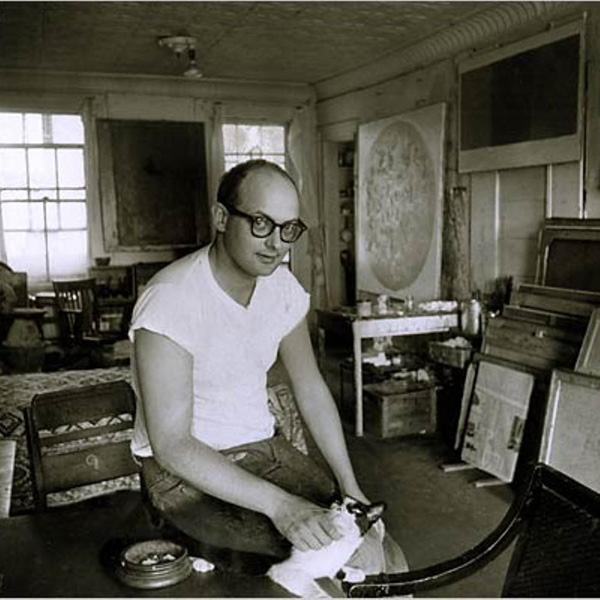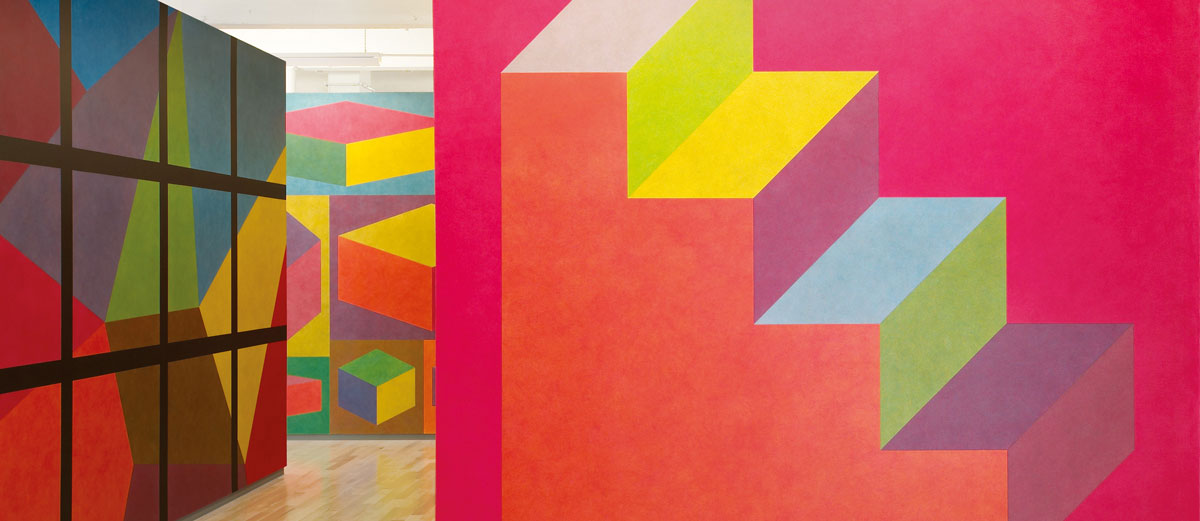TRACES: Sol LeWitt
 Today is the occasion to bear in mind Sol LeWitt (9/9/1928-8/4/2007), he was pivotal in the creation of the new radical aesthetic of the ‘60s that was a revolutionary contradiction to the Abstract Expressionism current in the ‘50s and ‘60s New York school. He had no interest in inherent narrative or descriptive imagery. LeWitt, like no other artist of his generation, had always maintained the importance of the concept or idea and, apart from his original works on paper, the work is executed by others to clear and strict instructions. Through documents or interviews, starting with: moments and memories, we reveal out from the past-unknown sides of big personalities, who left their indelible traces in time and history…
Today is the occasion to bear in mind Sol LeWitt (9/9/1928-8/4/2007), he was pivotal in the creation of the new radical aesthetic of the ‘60s that was a revolutionary contradiction to the Abstract Expressionism current in the ‘50s and ‘60s New York school. He had no interest in inherent narrative or descriptive imagery. LeWitt, like no other artist of his generation, had always maintained the importance of the concept or idea and, apart from his original works on paper, the work is executed by others to clear and strict instructions. Through documents or interviews, starting with: moments and memories, we reveal out from the past-unknown sides of big personalities, who left their indelible traces in time and history…
By Dimitris Lempesis
 Sol LeWitt was born in Hartford, Connecticut, his father, a doctor and inventor, died when he was 6. Soon after, he moved with his mother, a nurse, to live with an aunt in New Britain, Connecticut. His mother took him to art classes at the Wadsworth Atheneum in Hartford and he would draw on wrapping paper from his aunt’s grocery store. LeWitt received a BFA from Syracuse University in 1949 and then was drafted in the Korean War in 1951. During his service, he made posters for the Special Services and spent time in Japan. In 1953, he moved to New York City, where he studied at the Cartoonists and Illustrators and worked for Seventeen Magazine, making paste-ups, mechanicals and Photostats. He was then hired as a graphic designer in I.M. Pei’s architecture firm. In 1960, he took an entry-level job at the Museum of Modern Art, where he met Dan Flavin, Robert Ryman, Lucy Lippard and Robert Mangold. Together, through the “Sixteen Americans” exhibition, they were introduced to the work of Jasper Johns and Frank Stella and Robert Rauschenberg. LeWitt was also interested in Russian Constructivism, with its engineering aesthetic and the idea of making utilitarian art in an industrialized age. However, the work that influenced him the most was Eadweard Muybridge’s serial photography, sequential studies of people and animals in motion. LeWitt’s work from the early ‘60s, works on canvas coated with thick gestural oil paint, each featured one of Muybridge’s figures in motion. LeWitt’s three dimensional structural works from the mid to late ‘60s – such as “Three Part Variations on Three Different Cubes”, and hundreds of sculptures made of open white cubes grew out of this interest in the serial. He applied the same system of permutations and variations in his prints, drawings on paper and drawings on the wall. Sol LeWitt executed his first wall drawing in 1968 at Paula Cooper Gallery in New York. Like many of the wall drawings after this, “Wall Drawing #1” consisted of a system of parallel lines drawn with black pencil on a white wall in four directions. By drawing directly on the wall, the work’s duration was limited and ultimately the wall drawings are painted over. It also allowed him to achieve his objective of reinforcing flatness and making a work as two-dimensional as possible. This radical shift to drawing on the wall, followed the publication of “Paragraphs on Conceptual Art”. Although LeWitt drew “Wall Drawing #1” himself, he soon found that a team of assistants could oftentimes install his work better. He believed that the idea of his work superseded the art itself, as curator. In the late ‘70s, shortly after his first retrospective at The Museum of Modern Art and after numerous years of exhibiting in Italy, LeWitt moved to Spoleto, Italy. There he saw frescos by Fillippo Lippi, Massaccio, Fra Angelico and Giotto’s in local churches, museums and convents. In 1983, LeWitt’s art underwent a major transformation and he began to experiment with India ink and color ink washes, a nod to the local Trecento and Quattrocento works. After returning to the United States in the late ’80s, LeWitt made Chester, Connecticut, his primary residence. He died at age 78 in New York from cancer complications.
Sol LeWitt was born in Hartford, Connecticut, his father, a doctor and inventor, died when he was 6. Soon after, he moved with his mother, a nurse, to live with an aunt in New Britain, Connecticut. His mother took him to art classes at the Wadsworth Atheneum in Hartford and he would draw on wrapping paper from his aunt’s grocery store. LeWitt received a BFA from Syracuse University in 1949 and then was drafted in the Korean War in 1951. During his service, he made posters for the Special Services and spent time in Japan. In 1953, he moved to New York City, where he studied at the Cartoonists and Illustrators and worked for Seventeen Magazine, making paste-ups, mechanicals and Photostats. He was then hired as a graphic designer in I.M. Pei’s architecture firm. In 1960, he took an entry-level job at the Museum of Modern Art, where he met Dan Flavin, Robert Ryman, Lucy Lippard and Robert Mangold. Together, through the “Sixteen Americans” exhibition, they were introduced to the work of Jasper Johns and Frank Stella and Robert Rauschenberg. LeWitt was also interested in Russian Constructivism, with its engineering aesthetic and the idea of making utilitarian art in an industrialized age. However, the work that influenced him the most was Eadweard Muybridge’s serial photography, sequential studies of people and animals in motion. LeWitt’s work from the early ‘60s, works on canvas coated with thick gestural oil paint, each featured one of Muybridge’s figures in motion. LeWitt’s three dimensional structural works from the mid to late ‘60s – such as “Three Part Variations on Three Different Cubes”, and hundreds of sculptures made of open white cubes grew out of this interest in the serial. He applied the same system of permutations and variations in his prints, drawings on paper and drawings on the wall. Sol LeWitt executed his first wall drawing in 1968 at Paula Cooper Gallery in New York. Like many of the wall drawings after this, “Wall Drawing #1” consisted of a system of parallel lines drawn with black pencil on a white wall in four directions. By drawing directly on the wall, the work’s duration was limited and ultimately the wall drawings are painted over. It also allowed him to achieve his objective of reinforcing flatness and making a work as two-dimensional as possible. This radical shift to drawing on the wall, followed the publication of “Paragraphs on Conceptual Art”. Although LeWitt drew “Wall Drawing #1” himself, he soon found that a team of assistants could oftentimes install his work better. He believed that the idea of his work superseded the art itself, as curator. In the late ‘70s, shortly after his first retrospective at The Museum of Modern Art and after numerous years of exhibiting in Italy, LeWitt moved to Spoleto, Italy. There he saw frescos by Fillippo Lippi, Massaccio, Fra Angelico and Giotto’s in local churches, museums and convents. In 1983, LeWitt’s art underwent a major transformation and he began to experiment with India ink and color ink washes, a nod to the local Trecento and Quattrocento works. After returning to the United States in the late ’80s, LeWitt made Chester, Connecticut, his primary residence. He died at age 78 in New York from cancer complications.











